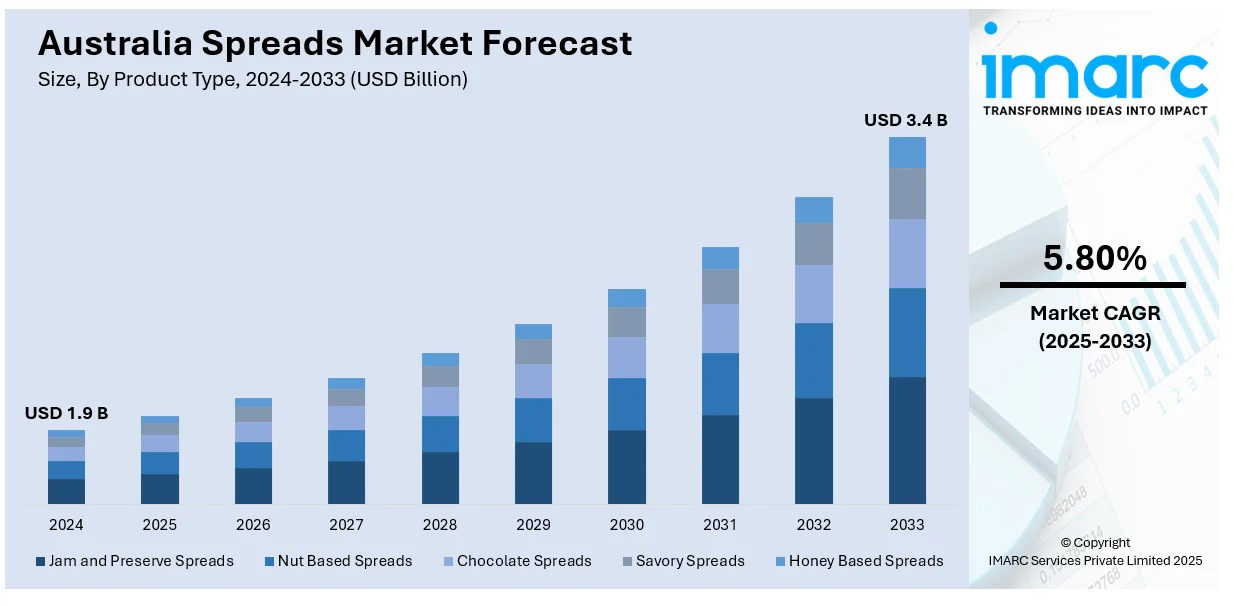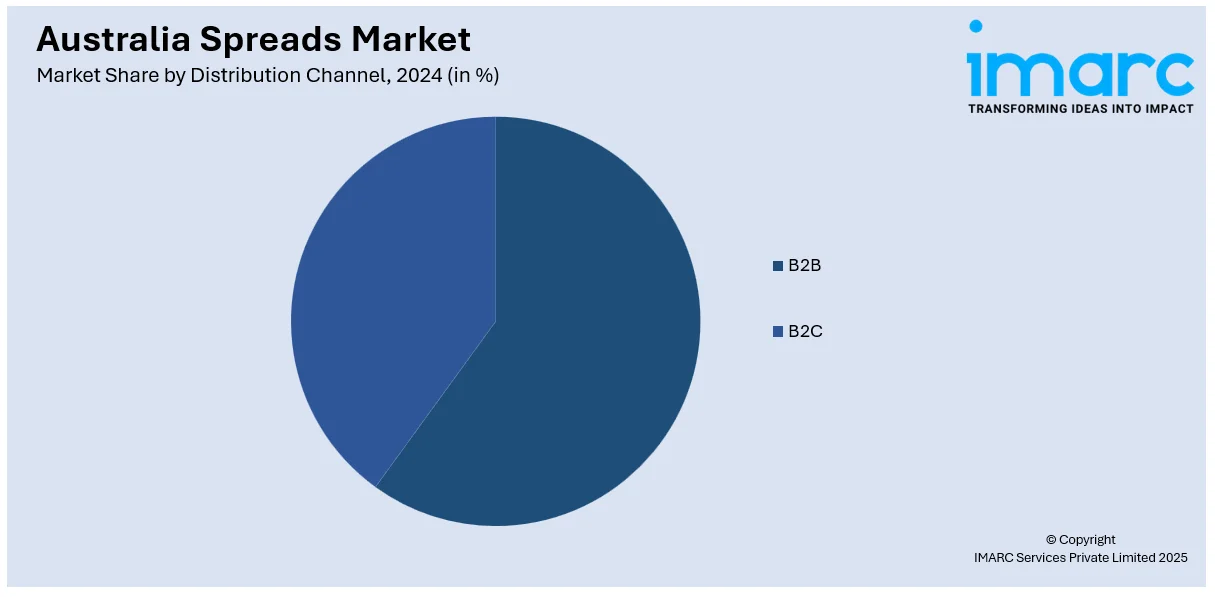
Australia Spreads Market Size, Share, Trends and Forecast by Product Type, Nature, Distribution Channel, End Use, and Region, 2025-2033
Australia Spreads Market Overview:
The Australia spreads market size reached USD 1.9 Billion in 2024. Looking forward, IMARC Group expects the market to reach USD 3.4 Billion by 2033, exhibiting a growth rate (CAGR) of 5.80% during 2025-2033. The market is fueled by the rising demand for functional spreads that offer additional health benefits, rising popularity of natural and organic spreads and increasing consumers preference for clean-label products with distinctive flavors and eco-friendly packaging. Moreover, innovation, convenience, and lifestyle trends continue to influence purchasing habits and widen the market appeal.
|
Report Attribute
|
Key Statistics
|
|---|---|
|
Base Year
|
2024
|
|
Forecast Years
|
2025-2033
|
|
Historical Years
|
2019-2024
|
| Market Size in 2024 | USD 1.9 Billion |
| Market Forecast in 2033 | USD 3.4 Billion |
| Market Growth Rate 2025-2033 | 5.80% |
Australia Spreads Market Trends:
Health-Conscious Consumer Trends
The strong shift toward health-conscious eating significantly is impacting the Australia spreads market growth. Consumers are looking for products that fit their wellness goals, due to which, the demand for natural and organic spreads is increasing. This trend is part of a larger global shift toward clean-label products and a desire for spreads made from whole fruits, nuts, and alternative natural sweeteners such as stevia and agave. Manufacturers are adapting to this shift by repositioning products with less amounts of added sugars and artificial content, in a bid to capitalize on increasing consumer demand for healthful choices. The move is driven by health consciousness, along with a need for openness in food labeling, leading to brands using more transparent ingredient declarations and sustainable sources. Therefore, the Australian spreads market is also experiencing a shift toward healthier and ethically manufactured products.

To get more information on this market, Request Sample
Innovation in Product Offerings
Innovation in product offerings is increasing the Australia spreads market share, with brands continuously expanding the variety of flavors and pack formats to accommodate varied consumer palates. Use of local ingredients and flavor elements in spreads is increasingly becoming popular, as evident from the multicultural food heritage of Australia. Examples include spreads infused with native Australian produce such as wattle seed, finger lime, or quandong, which are becoming common and provide consumers with regional and novel offerings. There is also a rising demand for functional spreads that offer additional health benefits, such as vitamins, minerals, or probiotics. This innovation also affects packaging, where brands are looking into sustainable materials and convenient formats to improve user experience and attract environmentally aware consumers. With these innovations, the Australian spreads market is becoming more diversified, offering consumers a wider variety of options that match their changing tastes.
E-Commerce and Digital Engagement
The growth of e-commerce is having a profound effect on the Australia spreads market outlook, providing brands with new opportunities to engage with consumers and evolve with shifting shopping habits. Online channels offer convenience and accessibility, enabling consumers to browse a broader range of spreads than might be found in local shops. Australia's e-commerce market reached unprecedented levels in 2024, as 9.8 million households spent over USD 69 billion online, based on a new report from Australia Post. In spite of economic difficulties, online shopping saw considerable expansion, propelled by changing consumer habits and developing market trends. The increasing cost of living was a major factor, with 93% of Australians looking for better deals online, resulting in higher digital sales than in-store transactions. According to Australia Post’s ‘eCommerce Report 2025’, online marketplaces significantly influenced the growth in overall online spending, accounting for 39%, which totals $16 billion. Hence, this online transition is supported by greater digital involvement, as brands utilize social media and digital marketing strategies to reach a technology-enabled audience. Collaborations with influencers and sponsored campaigns are becoming usual practices to increase brand presence and consumer confidence. Furthermore, easy access to in-depth product details and consumer feedback online equips consumers with the power to make informed buying choices. As e-commerce expands, it is likely to play a central role in determining the dynamics of the Australian spreads market, from what products are offered to how they are marketed.
Australia Spreads Market Segmentation:
IMARC Group provides an analysis of the key trends in each segment of the market, along with forecasts at the country and regional levels for 2025-2033. Our report has categorized the market based on product type, nature, distribution channel, and end use.
Product Type Insights:
- Jam and Preserve Spreads
- Nut Based Spreads
- Peanut Butter
- Almond Spreads
- Cashew Spreads
- Walnut Spreads
- Macadamia Spreads
- Chocolate Spreads
- Savory Spreads
- Honey Based Spreads
The report has provided a detailed breakup and analysis of the market based on the product type. This includes jam and preserve spreads, nut based spreads (peanut butter, almond spreads, cashew spreads, walnut spreads, and macadamia spreads), chocolate spreads, savory spreads, and honey based spreads.
Nature Insights:
- Organic
- Conventional
The report has provided a detailed breakup and analysis of the market based on the nature. This includes organic and conventional.
Distribution Channel Insights:

- B2B
- B2C
- Store-Based Retailing
- Online Retailing
A detailed breakup and analysis of the market based on the distribution channel have also been provided in the report. This includes B2B and B2C (store-based retailing and online retailing).
End Use Insights:
- Household/Retail
- Commercial
The report has provided a detailed breakup and analysis of the market based on the end use. This includes household/retail and commercial.
Regional Insights:
- Australia Capital Territory & New South Wales
- Victoria & Tasmania
- Queensland
- Northern Territory & Southern Australia
- Western Australia
The report has also provided a comprehensive analysis of all the major regional markets, which include Australia Capital Territory & New South Wales, Victoria & Tasmania, Queensland, Northern Territory & Southern Australia, and Western Australia.
Competitive Landscape:
The market research report has also provided a comprehensive analysis of the competitive landscape. Competitive analysis such as market structure, key player positioning, top winning strategies, competitive dashboard, and company evaluation quadrant has been covered in the report. Also, detailed profiles of all major companies have been provided.
Australia Spreads Market Report Coverage:
| Report Features | Details |
|---|---|
| Base Year of the Analysis | 2024 |
| Historical Period | 2019-2024 |
| Forecast Period | 2025-2033 |
| Units | Billion USD |
| Scope of the Report |
Exploration of Historical Trends and Market Outlook, Industry Catalysts and Challenges, Segment-Wise Historical and Future Market Assessment:
|
| Product Types Covered |
|
| Natures Covered | Organic, Conventional |
| Distribution Channels Covered |
|
| End Uses Covered | Household/Retail, Commercial |
| Regions Covered | Australia Capital Territory & New South Wales, Victoria & Tasmania, Queensland, Northern Territory & Southern Australia, Western Australia |
| Customization Scope | 10% Free Customization |
| Post-Sale Analyst Support | 10-12 Weeks |
| Delivery Format | PDF and Excel through Email (We can also provide the editable version of the report in PPT/Word format on special request) |
Key Questions Answered in This Report:
- How has the Australia spreads market performed so far and how will it perform in the coming years?
- What is the breakup of the Australia spreads market on the basis of product type?
- What is the breakup of the Australia spreads market on the basis of nature?
- What is the breakup of the Australia spreads market on the basis of distribution channel?
- What is the breakup of the Australia spreads market on the basis of end use?
- What is the breakup of the Australia spreads market on the basis of region?
- What are the various stages in the value chain of the Australia spreads market?
- What are the key driving factors and challenges in the Australia spreads market?
- What is the structure of the Australia spreads market and who are the key players?
- What is the degree of competition in the Australia spreads market?
Key Benefits for Stakeholders:
- IMARC’s industry report offers a comprehensive quantitative analysis of various market segments, historical and current market trends, market forecasts, and dynamics of the Australia spreads market from 2019-2033.
- The research report provides the latest information on the market drivers, challenges, and opportunities in the Australia spreads market.
- Porter's five forces analysis assist stakeholders in assessing the impact of new entrants, competitive rivalry, supplier power, buyer power, and the threat of substitution. It helps stakeholders to analyze the level of competition within the Australia spreads industry and its attractiveness.
- Competitive landscape allows stakeholders to understand their competitive environment and provides an insight into the current positions of key players in the market.
Need more help?
- Speak to our experienced analysts for insights on the current market scenarios.
- Include additional segments and countries to customize the report as per your requirement.
- Gain an unparalleled competitive advantage in your domain by understanding how to utilize the report and positively impacting your operations and revenue.
- For further assistance, please connect with our analysts.
 Request Customization
Request Customization
 Speak to an Analyst
Speak to an Analyst
 Request Brochure
Request Brochure
 Inquire Before Buying
Inquire Before Buying




.webp)




.webp)












